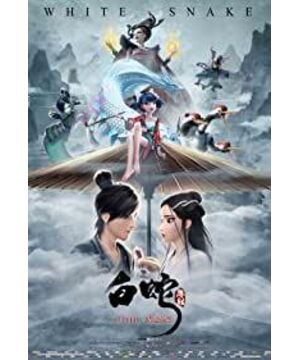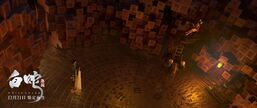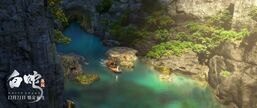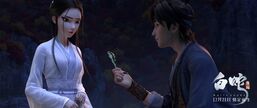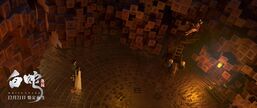In 2016, Wang Wei, one of the founders of Tudou.com, sold his shares and set up "Light Chasing Animation" with Youku's $100 million, and started his dream-chasing journey.
Light Chasing Animation has launched 3 films in a row within a few years: "Little Door God", "A Tang Qi Encounter" and "Cat and Peach Blossom Land", all directed and written by Wang Wei himself.
As a result, the three films suffered successive setbacks in the market. The box office dropped from 78 million to 30 million, and then to 20 million, and word of mouth also declined all the way. By the time of "Cat and Peach Blossom Land", it had almost reached the point of silence.
"Light Chasing" has good techniques, and there are various problems in the work, but there is one thing that people criticize, that is, the settings are too low and childish.
Obviously, the market is oriented towards the mainstream consumer group of animation - children.
This positioning itself is no problem, but it has its shortcomings in the Chinese market environment. Chasing light lacks big IP to fall back on, and rarely crowds New Year's gear. It is obviously not as attractive to children as "Bear Haunted" and "Pleasant Goat" with TV blessings, and children will not care about the fineness of the movie's pictures.
Adult audiences, who are more demanding of quality, are not calling for their stories and acting styles.
The two sides are not relied on, and the market performance itself is not good.
Finally, these problems have been improved in the fourth animated film "White Snake: Origin" of "Chasing Light".
Wang Wei no longer serves as director and screenwriter, and the power is handed over to animation director Huang Jiakang and young director Zhao Ji .
The story is no longer geared towards younger levels.
The opening chapter is Shuang Shu bathing, um, the adult Xiang did not run away.
The whole movie has made a lot of progress compared to Shimmer's previous works, but the inherent advantages and disadvantages are still very obvious.
For example, the picture is beautiful, the technology is solid, and many scenes can be captured frame by frame as wallpaper. This aesthetic style also fits well with the romantic theme of the film, and the film produced quite a few freehand pictures to create an atmosphere.
The action scenes are wonderful, and the rhythm of camera design and action design is very good.
The details are well captured, especially in conveying the feelings of the two, some tiny expressions and movements are very expressive and in place.
Some paragraphs are full of aura, such as the adventure of Baoqingfang and the adventure of the tunnel at the bottom of the tower. Although there are obvious signs of stealing from Japanese animation from the shape to the atmosphere, it is still good to be able to realize it.
The ink style attempt is very beautiful. Whether it is the ink fantasy at the beginning, or the colored ink Hangzhou city at the end, they are all exquisitely done and impressive.
The most rare thing is that this 3D animation is released in 2D format.
The downsides are the same as always.
The story is still cliché, the script has many bugs, and the logic cannot stand scrutiny.
The characters are still thin and the characters are rigid.
There is still a lack of enthusiasm for the use of camera language, and many turning points are very abrupt. Either the plot connection is missing or the picture explanation is not in place.
Some emotional expressions are also relatively blunt, the foreshadowing is not enough, the audience has not yet moved, and the characters are already in love.
It's scary to be caught off guard, but also to stop a passionate scene.
The face of the villain is a perfect replica of Thanos. Folklore is the monk Fahai. Here, we will change the painting of Taoist priests. The villain also engages in religious balance?
Most of the time, the expressions of the characters are still stiff, beautiful or beautiful, but they stay as if they just had hyaluronic acid.
Another issue that is not a shortcoming, but worth exploring, is the theme and style of the film.
Since "The Legend of the White Snake" is chosen as the mother, there is no doubt that the main line of the movie should be love.
From a commercial point of view, a lot of fighting scenes are also essential.
This creates stylistic swings and splits, and the story oscillates between romance and bloody fights.
The film does not allow the two elements to be well coordinated and integrated, but separate branches and leaves.
The audience can clearly feel where the film enters the lyrical passage, and where the fighting time begins again, with clear boundaries between each other.
The result is that the emotional ups and downs of the whole film are very small, and the emotions are intermittent, and the mobilization and guidance of the audience is obviously insufficient.
Until the climax of the final decisive battle and the great redemption, the audience did not have a particularly high emotional point waiting to be detonated.
But the beginning and end of "White Snake" are beautiful. With a dexterous pen-turn, this original story is connected with the Taiwan TV version of "The Legend of the New White Snake". The prelude to "Past Life and This Life" started, and the goose bumps on the body have already risen, the flute is melodious, and the memories are rolling in.
There is such a moment of moving, whether it is from a movie or a memory, it is enough.
PS: There are easter eggs at the end of the film, it is clear that I want to have a sequel.
View more about White Snake reviews


